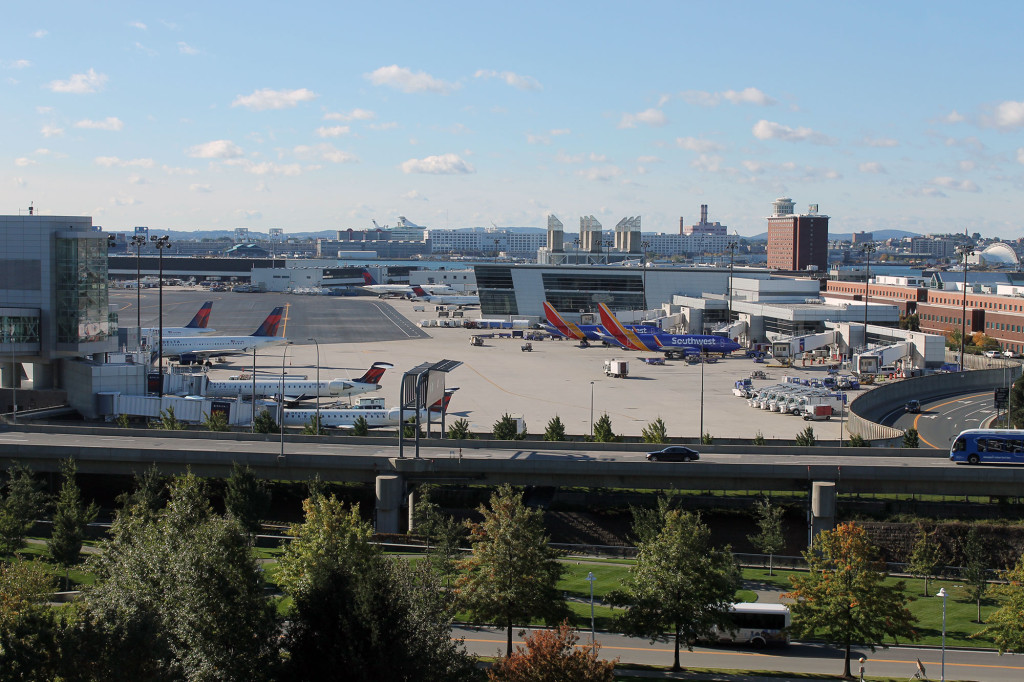Summary
Boston Logan International Airport (BOS) is one of the busiest airports in the United States and a significant hub for aviation enthusiasts. Located in East Boston, Massachusetts, Logan offers diverse spotting opportunities, thanks to its mix of domestic and international traffic, unique layout, and scenic views of the city and Boston Harbor.
A Brief History of Boston Logan

Logan Airport opened in 1923 as Jeffery Field and was initially used for military purposes. It became a public airport in the late 1920s and grew significantly after World War II.
Named after General Edward Lawrence Logan, a Massachusetts native and war veteran, the airport expanded rapidly to meet the demands of modern aviation. Today, Logan boasts four passenger terminals and six runways, handling over 40 million passengers annually.
Airport Layout and Operations

David Wilson, CC BY 2.0 <https://creativecommons.org/licenses/by/2.0>, via Wikimedia Commons
Logan International consists of four passenger terminals (A, B, C, and E) arranged in a central layout connected by shuttle buses and walkways.
- Terminals A, B, and C handle most domestic flights, with operators like Delta Air Lines, JetBlue, and American Airlines.
- Terminal E serves as the international gateway, accommodating airlines such as British Airways, Lufthansa, and Qatar Airways.
Logan’s six runways are aligned in various directions to handle Boston’s frequently changing weather. Key runways for plane spotting include:
- Runway 4R/22L: Often used for heavy departures and arrivals.
- Runway 15R/33L: Common for domestic traffic and a great location for spotting smaller jets.
Main Airline Operators

View of the Terminal A cul-de-sac

Cape Air are a major operator at Boston Logan. Photo (c) Steve Knight
Logan serves as a hub for JetBlue Airways and a focus city for Delta Air Lines and Cape Air. Key operators include:
- Domestic: American Airlines, Southwest Airlines, Spirit Airlines, and Alaska Airlines.
- International: Aer Lingus, British Airways, Air France, Lufthansa, Emirates, Qatar Airways, and Japan Airlines.
Logan’s diverse range of operators means plane spotters can see everything from narrow-body domestic aircraft to wide-body international jets, including the Airbus A380 and Boeing 787.
Top Plane Spotting Locations

Photo (c) Mark Bess

Hilton Boston Logan
Boston Logan offers several excellent locations for plane spotting, but it’s important to follow airport rules and local laws. Here are some of the best places to capture the action:
- Constitution Beach
- Overview: Located just north of the airport, Constitution Beach provides a clear view of arrivals and departures, particularly on Runway 4R/22L.
- Tips: Best lighting is in the morning. Bring a zoom lens for close-ups.
- Castle Island
- Overview: Situated in South Boston, Castle Island overlooks the Boston Harbor and offers views of aircraft approaching or departing Runway 15R/33L.
- Tips: Great for afternoon and evening photography, with the Boston skyline as a backdrop.
- Bremen Street Park
- Overview: This East Boston location offers decent views of Runway 9/27 operations. It’s a popular spot for families and spotters alike.
- Tips: Limited parking; arrive early for the best spots.
- Hotels with Views
- Hilton Boston Logan Airport: Rooms facing the runways provide direct views of the action.
- Tips: Check in advance to request a runway-facing room.
- South Cargo Road (Caution required)
- Overview: Located near the airport’s cargo facilities, this spot allows close-up views of planes taxiing or parked.
- Tips: Stay off private property and avoid blocking traffic.
Tips for Spotters at Logan

Photo (c) Steve Knight
- Best Times to Spot: Early mornings and late afternoons offer the best lighting conditions, particularly for photographing international arrivals and departures.
- Photography Equipment: A camera with a good zoom lens (200-400mm) is ideal for capturing aircraft on the runways or in the air.
- Weather Considerations: Boston’s weather can be unpredictable, so plan for changes, especially in winter.
- Follow Rules: Always respect airport security and stay in public areas designated for spotting. Avoid suspicious behavior, and be ready to explain your hobby if approached by authorities.
Have you been spotting at Boston Logan Airport? Leave a comment below and let us know your tips!
Title image: Mark Bess




